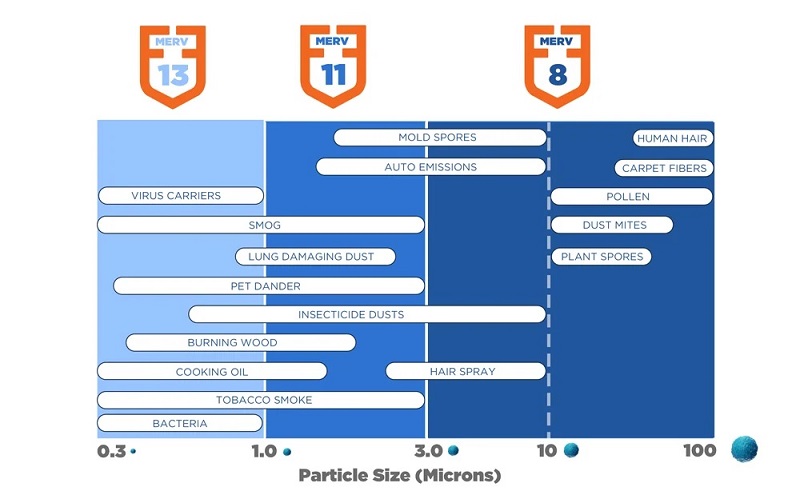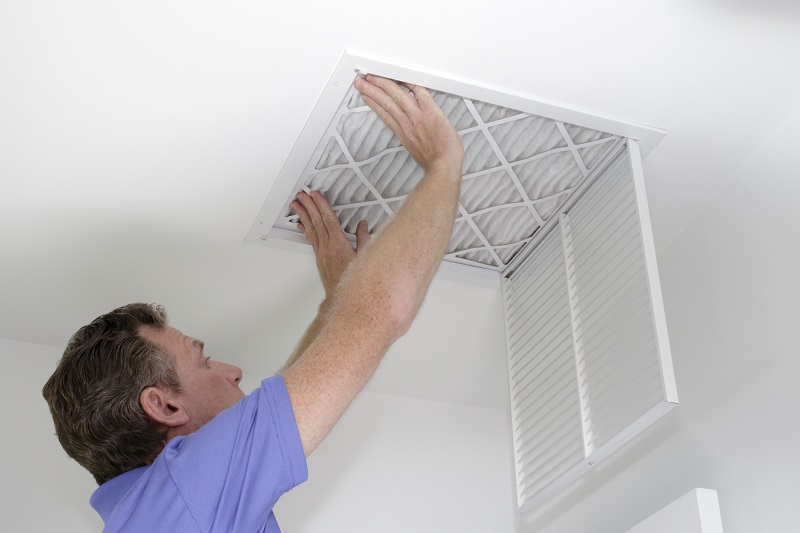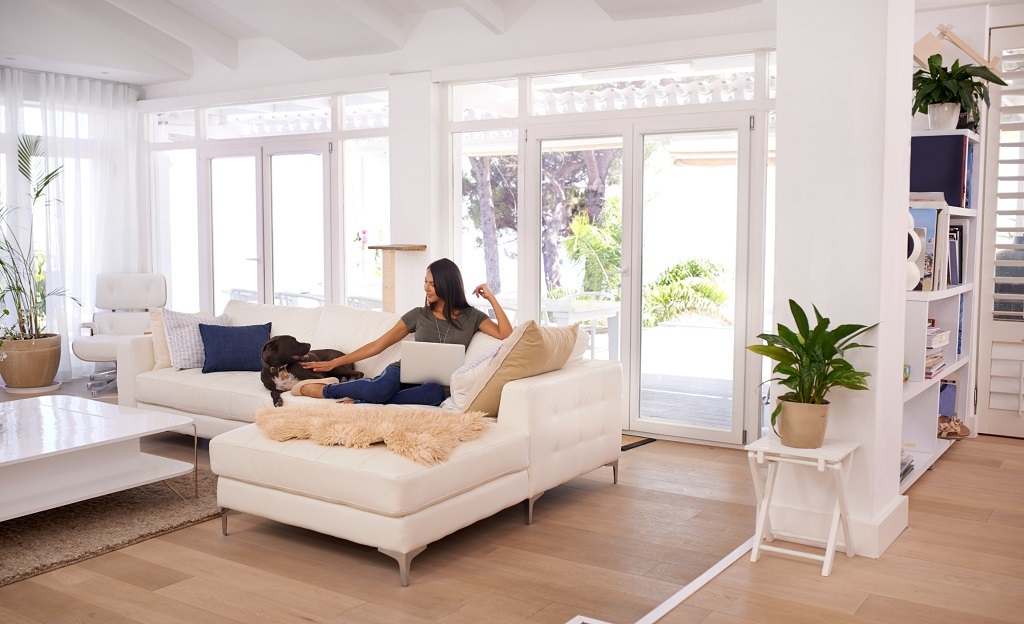A sneeze, a cough, a runny nose, a headache – it seems that no matter what time of year it is, many of us experience these dreaded and miserable allergy symptoms. Most of us are very aware that there are many allergens lurking outside, but have you ever considered the ones inside your home? Dust mites, outdoor pollen tracked in by shoes, pet dander, mold and even cockroaches can trigger allergy symptoms due to higher concentrations in less ventilated indoor air.
How can we create a healthier environment inside of our homes? How can you control indoor allergens?
Table of Contents
- What are Allergens?
- Main Sources of Indoor Allergens
- How to Control Indoor Allergens
- Simple Ways to Combat Allergens in Your Home
- Maintain All Household Filters
- Summary: Key Reminders
- Indoor Air Quality Resources
Also see these related Home Wellness articles:
What are Allergens?
Allergens are any substance that can cause an immune system reaction, as they are recognized as foreign or dangerous to a functioning immune system. Inflamed sensitive airways, itchy watering eyes and a runny nose can arise from any number of allergens, also referred to as “triggers”. The result is a cascade of symptoms, such as a runny nose, sneezing, coughing or experiencing headaches, all of which are associated with an “allergic reaction“.

Main Sources of Indoor Allergens
According to the EPA, the main sources of indoor allergens are:
- Pets and their dander
- Dust Mites
- Molds
- Cockroaches
- Wall-to-wall carpet
- Pollen tracked in by Outdoor Footwear
- Soft furniture
- Stuffed toys
- Bedding
- Damp areas
- Indoor plants
- Mattresses that aren’t in allergy covers
- Rodents
How to Control Indoor Allergens
The most effective way to eliminate allergic reactions is to improve air quality by reducing or eliminating the number of pollutants or allergens in the air. Since it is impossible to control outdoor air, a more practical approach would be to control the quality of your indoor environment. The best solution for those suffering from allergic reactions brought on by poor air quality is to remain indoors in a controlled or purified environment.
By reducing allergens in your home you can improve the overall quality of breathable air, and thus triggers to the immune system. Knowing the main sources of indoor allergens and systematically removing them can improve your indoor air quality and your allergic reactions dramatically.
Simple Ways to Combat Allergens in Your Home
It would be impossible to completely eliminate all allergens or pollutants from the air, even if you sealed up your home and ran air purifiers constantly. However, by reducing the concentrations of allergens, you can improve the body’s allergic reaction, thereby providing relief from the allergic cascade that occurs when the immune system is triggered.
- Remove Footwear
- Eliminate Mold
- Exterminate Pests
- Vacuum Twice a Week
Remove Footwear
Also, simple behaviors such as removing footwear before entering the home or leaving shoes in a mudroom or entrance hall will help reduce the amount of outdoor pollutants that are tracked throughout the home.
Eliminate Mold
Check your home for damp areas or possible mold growth near windows, around sinks, and toilets, while paying special attention to bathroom areas which may not be well ventilated, to prohibit and eliminate mold growth.
Also see:
Exterminate Pests
Keeping your home free of pests such as ants, cockroaches, dust and spider mites will help reduce triggers caused by their saliva, feces and shedding of body parts.
Also see:
Vacuum Twice a Week
Vacuum the home at least twice a week with a vacuum that has a HEPA filter. (HEPA is an acronym for High Efficiency Particulate Air, and correlates with the MERV Rating system, explained in the next section).
Regular vacuums allow smaller allergens to pass through the vacuum’s filter that causes pollutants to transfer from the carpet and sofa to the air. A better way to combat allergens indoors is by changing your vacuum filters or investing in a vacuum with a True HEPA filter and UV light like this doctor-recommended dust mite vacuum cleaner. Believe it or not, the type of vacuum cleaner that you use can affect your air quality.

Maintain All Household Filters
Vacuum filters are just one method of trapping and eradicating pollutants from indoor air. Maintaining other filters throughout the home goes a long way to keep the air quality high, while providing continuous coverage against air borne allergens.
- Furnace Filters
- Air Purifiers
- Vacuum Cleaner Filters
- Whole Home Air Purifiers
Furnace Filters
One of the easiest and most important steps in creating an allergy-free environment in your home is to select a furnace filter that meets your filtration needs and replace it regularly. When it comes to finding the furnace air filter that you need, you must first consider what MERV rating you need.
What is a MERV Rating?
MERV stands for Minimum Efficiency Reporting Value. Ratings range from 1 to 16 and indicate the filter’s ability to capture airborne particles. There are other air filter rating systems out there, but the MERV rating system is the industry standard, as it was created in 1987 by the American Society of Heating, Refrigerating, and Air-Conditioning Engineers (ASHRAE).

MERV rating chart to understand the effectiveness of air filters by particle size. Courtesy of FiltersFast.com.
What MERV rating you choose is important because the higher the MERV rating the more airborne contaminants the filter will capture. For allergy sufferers, the highest recommended rating is MERV 13. Air filters with a MERV 13 rating will capture common allergy triggers including pollen, dust mites, mold spores, and even pet dander. Ultra-effective HEPA filters have an equivalent rating of a MERV 17, literally “off the chart”!
When it comes to how often you should replace your furnace filters, it is ultimately up to you. For best results, it is recommended that you change them at least every 3 months. However, you should change your filters more frequently depending on the number of people and pets in your home. It is a good idea to get into the habit of checking your filter every month and changing it when needed.
Dreading having to remember when to change or order your home’s filters? You can choose to have your filters delivered when they need to be changed with a convenient filter subscription.
Don’t have a central heating and cooling system in your home? If you have a ductless or portable air conditioner, make sure you clean your filters regularly.

Air Purifiers
In addition to changing your furnace filters regularly, you can add an extra layer of protection by investing in an air purifier. There are many different types of air purifiers out there, but if you are looking for supreme air cleaning ability choose an air purifier with a True HEPA filter.
Unfortunately, True HEPA filters are too powerful to be installed in your home’s furnace system, but an air purifier with a True HEPA filter will capture 99.9% of airborne contaminants, as small as 0.3 microns.
A True HEPA filter will capture 99.9% of airborne contaminants
Vacuum Cleaner Filters
Since vacuum cleaners are used to keep surfaces in our homes clean, you need to clean or replace your vacuum cleaner’s filter to prevent allergy-triggering particles from going back into the air.
Whole Home Air Purifiers
If you’re interested in taking your home’s air quality to the next level, AprilAire’s Whole Home Air Purifier and MERV 13 Allergy Filters will keep your home’s air clean and comfortable. AprilAire’s Allergy Filters were designed specifically to capture particles in the air that can trigger asthma and allergies.
Summary: Key Reminders
Your indoor air quality is extremely important, especially if you suffer from allergies. Your home should be your safe place, so whether you choose one or many of these options, you will be creating a healthier, cleaner environment in your home.
Key Reminders to Creating an Allergy-Free Environment for Your Home:
- Know what the most common allergens are
- Identify the main sources of these allergens
- Reduce and control these allergens within your household
- Clean and replace your household filters regularly
Indoor Air Quality Resources
- Air Filters from FiltersFast
- At-Home Test for 40 Common Indoor and Outdoor Allergens from Everlywell
- Tips from the Mayo Clinic on How to Make Your Home Allergy-Proof
- Tips from AAFA (Asthma & Allergy Foundation of American) on How to Control Indoor Allergens
- Housecleaning Tips to Ease Allergies from WebMD
- Tips from the EPA on Improving Indoor Air Quality
- Residential Indoor Air Quality Guide from ASHRAE
- Natural Alternatives for a Healthier Household Cleaning Routine
Additional Home Wellness Articles
- Mold Removal: 4 Steps to Remediate Mold from Your Home
- Need Help Falling Asleep? Give These Sleep Tech Products a Try!
- Products to Turn Your Bathroom into a Health & Wellness Spa
- Are Smart Meters Harmful to Your Health?
- A Simple Guide to Choosing a Water Softener System
- How Acoustic Panels Can Help Mute Loud & Stressful Interior Spaces
| Purgula is reader-supported. When you click on links to other sites from our website, we may earn affiliate commissions, at no cost to you. If you find our content to be helpful, this is an easy way for you to support our mission. Thanks! Learn more. |







